
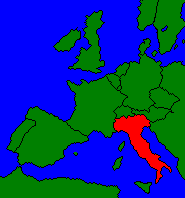
The Sixteenth Century
|
| The Ripieno | Tonal Characteristics | Appearance
Photograph | Review Quiz |


The Sixteenth Century
|
| The Ripieno | Tonal Characteristics | Appearance
Photograph | Review Quiz |
In Italy the application of a stop control mechanism to larger instruments lead to building organs (both large and small) with specific characteristics, usually identified by the term ripieno. The characteristics of the Italian ripieno are
| Ripieno Composition | ||||
|---|---|---|---|---|
| Italian Name | English Name | Length | Pitch | |
| Principale | Principal | 8' | C | |
| Ottava | Octave | 4' | c | |
| Quintadecima | 15th | 2' | c' | |
| Decimanona | 19th | 1 1/3' | g' | |
| Vigesimaseconda | 22nd | 1' | c" | |
| Vigesimasesta | 26th | 2/3' | g" | |
| Vigesimanona | 29th | 1/2' | c"' | |
| Trigesimaterza | 33rd | 1/3' | g"' | |
| Trigesimasesta | 36th | 1/4' | c"" | |
| Quadragesima | 40th | 1/6' | g"" |
Regardless of their basic pitch, if you look at it one way, the stops of the ripieno are the final dissolution of the medieval Blockwerk into individual ranks. Italian organs of the sixteenth century do not usually have compound stops, but, as you can see in the table above, the ripieno includes ranks which would be components of chorus mixtures on another type of instrument. Here they simply appear as individual stops.
One additional aspect of the ripieno gives Italian organs a distinctive sound:
Stops above 2' pitch break back one octave for notes that would sound above the topmost pipe of the 2' stop.For example, beginning at f#" the Decimanona, nominally a 1 1/3' stop, becomes a 2 2/3' stop. Similarly, beginning at c#", a Vigesimaseconda becomes a 2' stop rather than a 1' stop. When you play an ascending scale with all the stops of the ripieno drawn, the net effect of this arrangement is similar to that produced by chorus mixtures such as a Fourniture. The sound, however, is subtly different because of both the placement of breaks and the doubling of pitches when ranks break individually.
The stops of the ripieno were not the only ones on Italian organs of the period. These organs usually had a small number of flutes, the two most common being:
A final - - and unique - - stop must be mentioned in connection with sixteenth-century Italian organs. Although the stop is known by several different names, it is is essence a principal céleste - - i.e., a rank of principal pipes intentionally not in tune with the principale. The stop often played only in the upper register of the keyboard (above middle c, for example), and it was know by two different names - - each with its variant spellings:
You need to notice the second name in the list very carefully, so that you don't confuse it with the very different stop with a similar name: the Vox humana or Voix humaine. The non-Italian stop is a short-resonator reed of the regal family found on northern organs, but if you see this spelling on an organ in the United States, you are probably looking at a principal céleste.
The Italian voce humana is the only intentionally "out-of-tune" stop on sixteenth-century organs anywhere in Europe, although we see similar stops later throughout the continent and still later on organs worldwide. Even so, the sixteenth-century stop was not found on all Italian instruments, but was found for the most part in northern Italy.
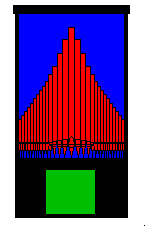 During the sixteenth century,
organs in both northern Europe and Italy developed specific identifying characteristics
-- elements of both design and construction that serve to identify them by sound
or by sight. While in the north the typical case was quite elaborate, the essential
Italian design is basically simple. In outline it is almost always a simple
rectangular box, with sides that go straight from the floor to the top of the
case. The black lines in the simplified drawing to the right represent the structural
parts of the case. The green space is one possible location of the keydesk,
although you might see it in other positions on some instruments. One possible
arrangement of Principale pipes in a façade is illustrated by
the red pipe shapes. If you pass your mouse pointer over the image, you'll see
another common arrangement of front pipes -- one more likely to be found in
larger instruments. In either version, the blue area represents the free space
within the case itself. This abundance of resonating space allows a thorough
blending of sound within the case before it is projected into the room, adding
a further distinctive quality to the timbre of Italian organs of the sixteenth
century and later.
During the sixteenth century,
organs in both northern Europe and Italy developed specific identifying characteristics
-- elements of both design and construction that serve to identify them by sound
or by sight. While in the north the typical case was quite elaborate, the essential
Italian design is basically simple. In outline it is almost always a simple
rectangular box, with sides that go straight from the floor to the top of the
case. The black lines in the simplified drawing to the right represent the structural
parts of the case. The green space is one possible location of the keydesk,
although you might see it in other positions on some instruments. One possible
arrangement of Principale pipes in a façade is illustrated by
the red pipe shapes. If you pass your mouse pointer over the image, you'll see
another common arrangement of front pipes -- one more likely to be found in
larger instruments. In either version, the blue area represents the free space
within the case itself. This abundance of resonating space allows a thorough
blending of sound within the case before it is projected into the room, adding
a further distinctive quality to the timbre of Italian organs of the sixteenth
century and later.
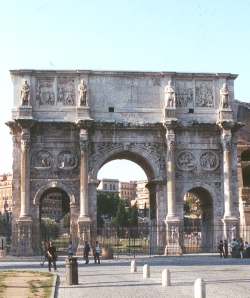 There
is one other element commonly seen in Italian organ façades -- a Roman
arch. Don't forget that the Italian case developed during the Renaissance, when
many elements of the past were absorbed into contemporary artistic styles. In
Italy, after all, there were a lot of surviving Roman structures, so models
were readily available. One of the distinguishing components of ancient Roman
architecture is the use of the rounded arch, with what is basically a semicircular
top above parallel columns or pillars. The photograph below shows Constantine's
Arch, one of the sights you will see between the Colosseum and the Forum when
you visit Rome. Look at the basic shape of the central arch, repeated in the
smaller arches to the side. That's the basic shape you'll find in almost all
surviving structures of ancient Rome, and it's a shape that was taken over into
Renaissance art in Italy during the time that the fundamental properties of
Italian organ case developed.
There
is one other element commonly seen in Italian organ façades -- a Roman
arch. Don't forget that the Italian case developed during the Renaissance, when
many elements of the past were absorbed into contemporary artistic styles. In
Italy, after all, there were a lot of surviving Roman structures, so models
were readily available. One of the distinguishing components of ancient Roman
architecture is the use of the rounded arch, with what is basically a semicircular
top above parallel columns or pillars. The photograph below shows Constantine's
Arch, one of the sights you will see between the Colosseum and the Forum when
you visit Rome. Look at the basic shape of the central arch, repeated in the
smaller arches to the side. That's the basic shape you'll find in almost all
surviving structures of ancient Rome, and it's a shape that was taken over into
Renaissance art in Italy during the time that the fundamental properties of
Italian organ case developed.
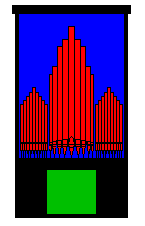 In
Italian organs, this basic shape was applied to the face -- the façade
of the instrument. Look at this second drawing of the structural outline of
a typical Italian instrument. This time, when you pause your mouse pointer over
the drawing, you will see an animation that first
In
Italian organs, this basic shape was applied to the face -- the façade
of the instrument. Look at this second drawing of the structural outline of
a typical Italian instrument. This time, when you pause your mouse pointer over
the drawing, you will see an animation that first
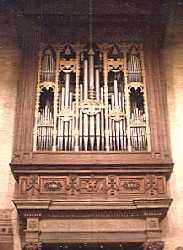 You would expect a real musical
instrument to be decorated in the style of the day, of course, and as you look
at Italian organs from the sixteenth century, you will find a balanced, symmetrical
layout of pipes in the front of a basic rectangular case. This simple structure
will then be decorated with additional characteristics that make these cases
look like sculptural objects as well as musical instruments. For example, the
photograph to the left is of one of the two organs in the Church of Santa Croce
in Florence. Built in 1579 by Nefori da Cortona, the case exhibits the characteristics
listed in the paragraph above in that the case itself has a rectangular front
whose height is determined by the size of the center pipe. The façade
pipes are displayed in a more elaborate pattern, following the typical design
features of the area around Florence: three flat towers in the center between
two double-story flats, and the whole is decorated with carvings, both plain
and gilded. Although the instrument itself has been modified since its installation,
the case remains a testament to the endurance of the basic Italian design.
You would expect a real musical
instrument to be decorated in the style of the day, of course, and as you look
at Italian organs from the sixteenth century, you will find a balanced, symmetrical
layout of pipes in the front of a basic rectangular case. This simple structure
will then be decorated with additional characteristics that make these cases
look like sculptural objects as well as musical instruments. For example, the
photograph to the left is of one of the two organs in the Church of Santa Croce
in Florence. Built in 1579 by Nefori da Cortona, the case exhibits the characteristics
listed in the paragraph above in that the case itself has a rectangular front
whose height is determined by the size of the center pipe. The façade
pipes are displayed in a more elaborate pattern, following the typical design
features of the area around Florence: three flat towers in the center between
two double-story flats, and the whole is decorated with carvings, both plain
and gilded. Although the instrument itself has been modified since its installation,
the case remains a testament to the endurance of the basic Italian design.
 Of
course, when you talk about Italian art in the sixteenth century, you think
of color, grandeur, expressive lines, and all the other characteristics of the
late Renaissance and early Baroque styles. The organ shown on the right is in
the Cathedral of Orvieto, a picturesque town about an hour north of Rome. The
town itself is memorable as the site of the miracle that inspired the foundation
of the Feast of Corpus Christi in the thirteenth century. The organ case was
designed in the sixteenth century by Ippolito Scalza, and it illustrates another
way in which the basic Italian design could be decorated. In this instance,
the organ façade calls to mind the appearance of an elegant palace or
overwhelming church building of the same era.
Of
course, when you talk about Italian art in the sixteenth century, you think
of color, grandeur, expressive lines, and all the other characteristics of the
late Renaissance and early Baroque styles. The organ shown on the right is in
the Cathedral of Orvieto, a picturesque town about an hour north of Rome. The
town itself is memorable as the site of the miracle that inspired the foundation
of the Feast of Corpus Christi in the thirteenth century. The organ case was
designed in the sixteenth century by Ippolito Scalza, and it illustrates another
way in which the basic Italian design could be decorated. In this instance,
the organ façade calls to mind the appearance of an elegant palace or
overwhelming church building of the same era.
You will have to use the "back" button on your browser to return to this page. The extremely large size of this image means that loading it will take an unduly long time if you are viewing these pages through a modem connection.
© 1998 James H. Cook